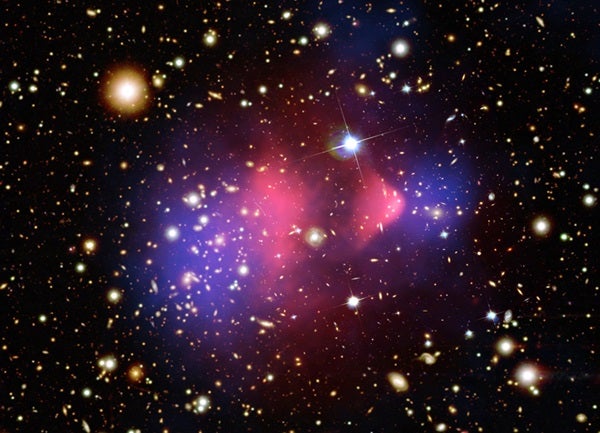Over a hundred years since it was first theorized, physicists have yet to discover solid evidence for a dark matter particle, despite the many experiments searching for it. Most physicists are sure that it’s there, but its elusive nature has becoming increasingly frustrated the harder they try.
What is keeping us from discovering dark matter? Rapidly advancing technology has exponentially improved every project, cornering dark matter particles into an ever-shrinking possible form of existence as certain types of dark matter are eliminated from the possible roster. This is of course very helpful, but one pair of researchers thinks that this hyper-focus might be working against our search for these elusive particles. Teamwork between two different camps, Annika Peter of Ohio State University believes, will be the key to discovering dark matter moving forward.
Communication breakdown
There are two methods that physicists use to discover dark matter, and they differ greatly. Particle physics focuses on the small-scale world — the subatomic properties of matter — whereas astronomy focuses on the large-scale world — faraway areas of the universe that we can probe with telescopes and signal detectors. Naturally, they use different approaches.
“The language and tools we [physicists and astronomers] use tend to be quite different,” Peter, an assistant professor of physics and astronomy, says. “Particle physicists care a lot about defining the microphysical properties of dark matter, like what dark matter’s particle properties are. Astronomers focus on the macroscopic properties of dark matter, like how it’s distributed in the universe and how we can tell that it’s there.”
Taking two approaches isn’t inherently flawed, but given that researchers haven’t discovered definitive evidence for dark matter, Peter and her colleague Matthew Buckley, a theoretical physicist at Rutgers University, believe that uniting these fields of study could help guide researchers toward discovery.
“If you aren’t aware that dark matter can have interesting interactions we aren’t aware of yet, then as an astronomer, you’re not going to go looking for them,” Buckley says. “If you’re not aware of the relevance of new astronomical surveys to galaxy formation, then as a particle physicist, you’re not going to spend time thinking about what that can tell you about dark matter.”
Peter credits her diverse background as a physics student to helping her carve this path.
“I was a physics grad student, but I loved astronomy and took a few astronomy classes for fun,” Peter says. “So I felt like I got a solid foundation in physics but also in astronomy. I feel like having that breadth has really been a strength.”
In their paper, Peter and Buckley discuss the history of the search for dark matter and the major leaps in knowledge that have occurred in particle physics and astronomy. (A shorter, more reader-friendly blog post can be found here.)
“I think we’re seeing another wave of major leaps happening right now,” Peter says. “So one of the purposes of this paper is to outline, for people looking for these kinds of opportunities in astrophysics and cosmology, where those opportunities might lie.”
It would be hubris to assume that we would automatically be able to detect dark matter in a lab just because we are searching for it. Perhaps dark matter only interacts with itself aside from gravitational effects, or perhaps there is an entire “Dark Matter Standard Model” similar to the Standard Model of normal matter scientists use to describe the universe. That’s where astronomy comes in, to hone in on its properties based on the gravitational interactions with matter that we can see.
Current experiments
There are many experiments currently searching for dark matter. Experiments like SuperCDMS and Xenon1T use direct detection methods, hoping to get a dark matter particle to bump into the material in the detectors and produce a reaction that researchers can measure.
Laboratories like SNOLAB, where SuperCDMS is housed, are built far underground, oftentimes in vacated mine shafts, to help block out some of the high-energy cosmic rays flooding into the detectors. It doesn’t block all incoming particles, but in a universe with so much cosmic noise, anything helps.
Astronomical approaches require a broader method of observation. Telescopes like the Large Synoptic Survey Telescope (LSST) will provide an improved ability to map the cosmos, giving researchers a plethora of data on several billion galaxies. By being able to study the masses of these galaxies and their gravitational influence on the surrounding environment, researchers hope to narrow down their idea of what dark matter is and learn more about its nature.
LSST is special because it will be able to track changes in the sky. Many telescopes are only built to scan the sky once to build a map. LSST will collect data regularly for about ten years.
“It’s not just going to map the sky once, but it’s going to map the sky many times over the course of its life,” Peter says. “If you can think of a test of dark matter that works on time-dependence, a time of about a decade, then LSST is a good tool for that.”
What’s next?
Astronomers and particle physicists alike are hopeful that a new era of technology can help them figure out the enigma of dark matter. Astronomers will be relying on particle physicists to provide insight on how the atomic structure of possible dark matter particles, like Weakly-Interacting Massive Particles (WIMPs) or other hypothesized particles, could gravitationally affect their environments and affect observations. Particle physicists will be working to improve their detection methods in the hope that they find their unicorn: a dark particle.
“These days I try to be very open-minded about the possibilities of dark matter,” Buckley says. “I’ll take any new unambiguous evidence for a particle beyond the Standard Model that suggests where we go next. That will keep me happy and busy for a long time.”











